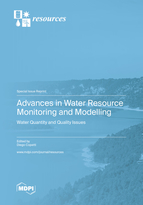Advances in Water Resource Monitoring and Modelling: Water Quantity and Quality Issues
A special issue of Resources (ISSN 2079-9276).
Deadline for manuscript submissions: closed (28 February 2023) | Viewed by 36137
Special Issue Editor
Interests: applied ecology; water quality; biogeochemistry; environmental monitoring and modelling; management of water resources; climate change impact on surface waters; sustainability; ecosystem services
Special Issues, Collections and Topics in MDPI journals
Special Issue Information
Dear Colleagues,
Advances in environmental monitoring and modelling can help in the management of water resources. The availability of water is being put at risk by pressures acting at both the local (e.g., nutrient/pollutant loads) and the global (e.g., climate change) scale. The increasing pressure on water resources can be either quantitative or qualitative threats. Monitoring of the water resource thus has to cover both of these aspects. In recent years, there has been an increase in data availability, including both in situ and remote-sensing data. If, on the one hand, the availability of these big datasets is increasing our knowledge on aquifers, on the other hand, the management of these data implies the development of advanced tools to validate, store and process these data. The use of advanced mathematical and statistical models is a central aspect of this rapidly evolving field of research. Models, in fact, are fundamental tools for predicting water availability and quality, in relation to different potential uses (e.g., irrigational, drinking supply), and under both local and global stresses. This Special Issue deals with advances in all of the different fields of research related to monitoring and modelling water research, including: in situ sensor and sensor network development, advances in remote sensing data acquisition, data storage and validation, statistical and process-based model implementation. Contributions dealing with methods to merge modelled and measured data (e.g., data assimilation techniques) or data driven computational methods (e.g., machine learning) are also welcome.
Dr. Diego Copetti
Guest Editor
Manuscript Submission Information
Manuscripts should be submitted online at www.mdpi.com by registering and logging in to this website. Once you are registered, click here to go to the submission form. Manuscripts can be submitted until the deadline. All submissions that pass pre-check are peer-reviewed. Accepted papers will be published continuously in the journal (as soon as accepted) and will be listed together on the special issue website. Research articles, review articles as well as short communications are invited. For planned papers, a title and short abstract (about 100 words) can be sent to the Editorial Office for announcement on this website.
Submitted manuscripts should not have been published previously, nor be under consideration for publication elsewhere (except conference proceedings papers). All manuscripts are thoroughly refereed through a single-blind peer-review process. A guide for authors and other relevant information for submission of manuscripts is available on the Instructions for Authors page. Resources is an international peer-reviewed open access monthly journal published by MDPI.
Please visit the Instructions for Authors page before submitting a manuscript. The Article Processing Charge (APC) for publication in this open access journal is 1600 CHF (Swiss Francs). Submitted papers should be well formatted and use good English. Authors may use MDPI's English editing service prior to publication or during author revisions.
Keywords
- sensors
- sensors network
- remote sensing
- process based models
- statistical models
- machine learning methods
- data assimilation techniques
- water quantity
- water quality
- water management
- sustainability
- Long term trends
- Integrated analitical approaches






